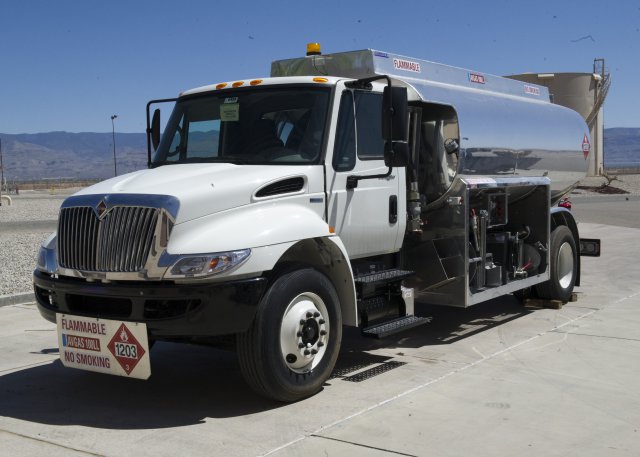 Holloman Air Force Base is home to the first two new aviation gasoline trucks in Air Combat Command’s inventory that were specifically designed to support the MQ-1 Predator remotely piloted aircraft.
Holloman Air Force Base is home to the first two new aviation gasoline trucks in Air Combat Command’s inventory that were specifically designed to support the MQ-1 Predator remotely piloted aircraft.
“They were uniquely designed, ordered, and built for the MQ-1 mission here,” said MSgt. Jason Bowman, section chief for the 49th Logistics Readiness Squadron’s Fuels Information Service Center.
These are the first two AVGAS-specific trucks in Air Combat Command’s inventory, said Master Sgt. Jason Bowman, 49th LRS Fuels Information Service Center section chief.
“JP-8 fuel is primarily for aircraft with a jet or turbine engine, where as smaller prop engine aircraft run off of AVGAS,” Bowman said. “The primary purpose for our AVGAS trucks is to service the wing’s MQ-1 aircraft. They were uniquely designed, ordered and built for the MQ-1 mission here. Our R-11 refueling trucks pump at a much higher flow rate, but these AVGAS trucks service smaller framed aircraft at a much slower dispensing rate.”
Because the wing’s R-11 fuel truck fleet only carries JP-8, MQ-1 fuel operations used to demand additional work hours from fuel distributors, but with their new AVGAS trucks, fuel distributors will save about 1,500 work hours per year, said Senior Master Sgt. Jon Voigt, 49th LRS Fuels Management Flight chief.
“Right now we are filling these aircraft in an archaic method,” Bowman said. “We order barrels of fuel, which come in 55-gallon drums. When those drums come in we have to transfer the fuel to our operating tank, which then leaves an empty drum for us to turn into (Defense Reutilization and Marketing Office) to dispose of. We go through about 36 to 40 of these barrels a month, so with this we are eliminating a hazardous waste stream.”
The AVGAS trucks, Voigt said, will allow fuel distributors to handle the MQ-1’s fuel servicing like they would any other aircraft. “It gives us complete oversight of what’s going into these planes,” he said. “Instead of dealing with packaged petroleum products, now we have a bulk storage tank so we won’t run the risk of inventory deficiencies.”
The main inventory deficiency, Bowman said, is vapor loss, which occurs when fuel heats up, evaporates into a gas, and boils off. “Since the trucks were designed for the storage of AVGAS, they will reduce that,” he said. “With the 55- gallon drums as our current storage tank, we lose fuel every month due to evaporation. These trucks will minimize that. Most importantly, the trucks are going to allow us to provide a better quality of fuel to our end user.”
The inventory deficiencies, Bowman said, is what originally motivated the fuels management flight to aggressively find a solution to their problems. “The Air Force really didn’t choose Holloman to have these trucks; the fuels management flight took the initiative and pursued this,” he said. “We noticed that because of the product loss and fuel quality concerns, we needed to find a better way of doing business. So we took and drafted the initiative, and approached Air Combat Command. Now that we’ve done this, several other bases are following suit.”
Coincidently, Bowman said, some of the short-term and long-term benefits of the AVGAS trucks mirror each other. “The immediate benefit it gives us is the cost savings,” he said. “We’re going to be saving, depending on the time of year, an estimated $2 to $4 per gallon. Typically we pump 3,000 gallons a month, so on the low end, we’re going to be saving $6,000 per month. The long term benefit will be the better quality of fuel that we’re putting into our aircraft, which will elongate the lifespan of the aircraft’s engine.”
Perhaps the biggest benefit the trucks provide is their versatility. “When the MQ-1s leave, these trucks can be used to dispense other grades of fuel,” Voigt said. “It has a filter vessel just like the R-11s do, and has a hose that can interface with a fighter aircraft, smaller aircraft, or helicopter. A lot of the training planes and helicopters have an open port fueling receptacle where basically you just stick the fueling nozzle in and issue fuel.”
Source: Air Combat Command

This article is not entirely accurate…..We at the 163rd RW March ARB California had a custom build C301 (retrofitted AVGAS 100LL) truck built back in 2010. We also were the first flying unit period to have this truck. Myself and a my ANG FAM started putting this idea together back in 2006. The Air Force can save a lot money buy simply updating their existing vehicles i.e. C300/C301 to pump AVGAS…instead of buying a whole new truck…..Isometrics designed the pumping system for us.